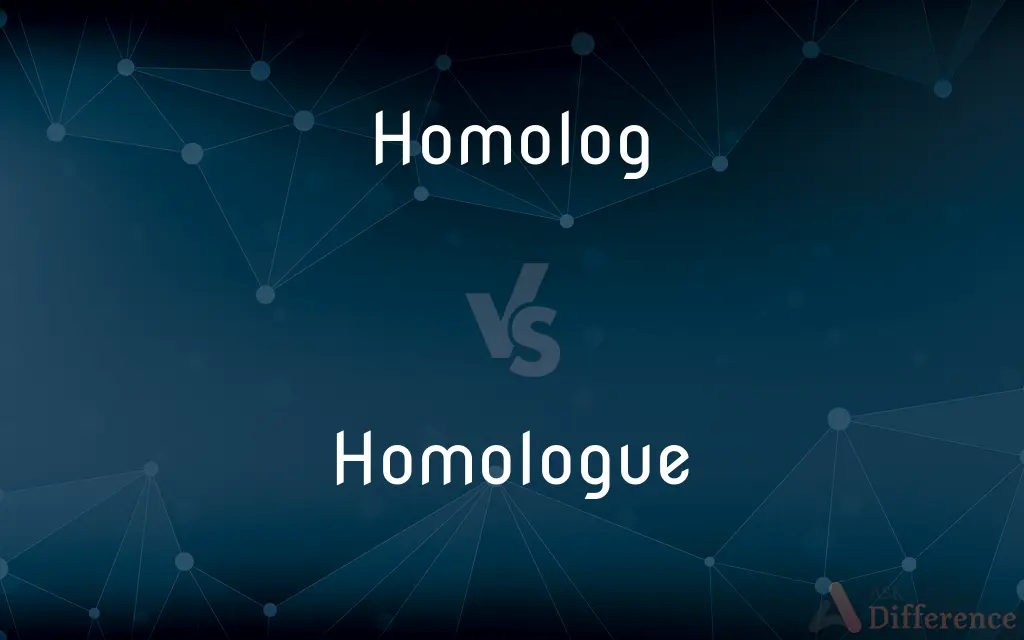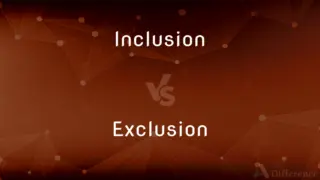Homolog vs. Homologue — What's the Difference?
By Maham Liaqat & Urooj Arif — Updated on April 3, 2024
Homolog refers to genes related by descent from a common ancestor, while homologue can refer to either genes or analogous structures in different species.

Difference Between Homolog and Homologue
Table of Contents
ADVERTISEMENT
Key Differences
Homolog is a term used primarily in genetics to describe genes that are related by descent from a common ancestral DNA sequence. This relation can be within the same species (orthologs) or between different species (paralogs). On the other hand, homologue is a broader term that can refer to genes that have a similar sequence and are believed to be descended from a common ancestor, but it can also refer to similar structures in different species that are not necessarily genetically related.
The concept of homology is critical in evolutionary biology, as it helps scientists understand how species have diverged from common ancestors over time. Homologs, in this sense, provide evidence of evolutionary relationships. Whereas, homologues can be used to discuss both genetic and structural similarities, such as the wings of birds and bats, which are structurally similar yet evolved independently.
In genetics, identifying homologs is essential for understanding the function of genes across different organisms. This knowledge can reveal how certain traits or diseases are conserved through evolution. Homologues, when referring to structures, allow biologists to study the principles of convergent evolution, where different evolutionary paths result in similar adaptations.
The use of homolog is more specific and is confined to the realm of genetics and molecular biology. It is concerned with the lineage and genetic information passed down through generations. In contrast, homologue spans a broader scope, encompassing both genetic sequences and anatomical structures across different species, thus providing a more general comparison of similarity.
Both terms are crucial for comparative biology, yet they serve different purposes. Homologs underline the genetic continuity and evolutionary relationships, highlighting how organisms evolve and diversify. Homologues, encompassing a wider range of similarities, illustrate the concept of evolutionary convergence and the adaptability of life in various environmental niches.
ADVERTISEMENT
Comparison Chart
Definition
Genes related by descent from a common ancestor.
Refers to genes or structures in different species that are similar due to evolutionary descent or analogous function.
Usage in Biology
Specific to genetics and evolutionary relationships.
Used more broadly for both genetic and structural similarities.
Related Concepts
Orthologs, paralogs (types of homologs).
Convergent evolution, analogous structures.
Importance
Understanding gene function and evolutionary pathways.
Studying evolutionary relationships and principles of convergence.
Example
The hemoglobin gene in humans and chimpanzees.
Wings of birds and bats, as well as genes descended from a common ancestor.
Compare with Definitions
Homolog
Genes inherited from a common ancestor.
The homolog of the human FOXP2 gene in mice is involved in speech and language.
Homologue
Genes or structures in different species with a common evolutionary origin.
The wing of a bird and the arm of a human are considered homologues.
Homolog
A member of a homologous pair of chromosomes.
During meiosis, homologs pair up for recombination.
Homologue
Can refer to analogous structures that evolved independently.
The wings of birds and insects are homologues despite their different evolutionary paths.
Homolog
Used in comparative genomics.
Homologs are essential for understanding evolutionary relationships.
Homologue
Reflects both genetic and functional similarity.
Enzymes that catalyze similar reactions in different species are homologues.
Homolog
Essential for studying gene function.
By comparing homologs, scientists can predict the function of unknown genes.
Homologue
Used in both genetics and comparative anatomy.
Homologues help trace the evolutionary history of species.
Homolog
Refers to similar sequences in DNA or RNA.
Homologs can be identified through sequence alignment techniques.
Homologue
Supports the study of evolutionary convergence.
The similar eye structures in octopuses and humans are an example of homologues.
Homolog
Something that is homologous, as an organ, body part, or gene.
Homologue
Variant of homolog.
Homolog
Something homologous; a homologous organ or part, chemical compound or chromosome.
Homologue
Something homologous; a homologous organ or part, chemical compound, chromosome, gene, or cultural element.
Homolog
(linguistics) A word shared by two languages or dialects.
Homologue
(linguistics) A phoneme, morpheme, or word shared by two languages or dialects, via cognation or naturalize.
Homolog
(genetics) One of a group of similar DNA sequences that share a common ancestry.
Homologue
One of a group of similar DNA sequences that share a common ancestry, or the peptides or proteins that they encode; the counterpart gene or protein in another taxon evolved from a common ancestor (molecularly it may be either identical or similar).
TP53 is the human homologue of murine Trp53.
Homolog
(organic chemistry) A member of a homologous series.
Homologue
(organic chemistry) A member of a homologous series.
Homologue
(cultural anthropology) A belief, practice, concept, or artifact that has a counterpart in another culture.
Homologue
That which is homologous to something else; as, the corresponding sides, etc., of similar polygons are the homologues of each other; the members or terms of an homologous series in chemistry are the homologues of each other; one of the bones in the hand of man is the homologue of that in the paddle of a whale.
Common Curiosities
How do homologs help in evolutionary biology?
Homologs provide insights into how species have diverged from common ancestors, helping scientists trace evolutionary pathways and gene function across organisms.
What can be considered a homologue?
A homologue can refer to genes with a similar sequence from a common ancestor or similar structures in different species, whether through common descent or convergent evolution.
Can homologues indicate evolutionary convergence?
Yes, homologues can indicate evolutionary convergence by showing how different evolutionary paths can lead to similar adaptations or structures in diverse species.
What role do homologues play in comparative anatomy?
In comparative anatomy, homologues illustrate how similar structures or functions have evolved in different species, either through shared ancestry or convergent evolution.
How does understanding homologs and homologues benefit medical research?
Understanding these concepts aids in identifying gene functions and disease mechanisms across species, facilitating the development of treatments and therapies.
What is a homolog in genetics?
A homolog in genetics is a gene related by descent from a common ancestral DNA sequence, important for understanding evolutionary relationships.
How are homologs identified?
Homologs are identified through genetic sequence comparisons, looking for similarities that suggest a common ancestral origin.
Why is the distinction between homolog and homologue important?
The distinction is crucial because homolog is specific to genetics, focusing on descent and evolutionary relationships, while homologue encompasses a broader range of similarities, including structural and functional analogies across species.
Is the function of homologs always conserved?
While the basic structure of homologs may be conserved, their functions can diverge significantly over evolutionary time, reflecting the adaptation to different environments or roles.
How do homologs contribute to phylogenetic analysis?
Homologs are used in phylogenetic analysis to reconstruct the evolutionary histories of species, based on the similarities and differences in their genetic sequences.
What is an example of a homolog in humans and another species?
An example is the CYCLOPS gene, which is involved in eye development in humans and is homologous to a gene in fruit flies performing a similar function.
What is the difference between orthologs and paralogs?
Orthologs are genes in different species that evolved from a common ancestral gene by speciation, whereas paralogs are genes related by duplication within a genome that may evolve new functions.
Can a structure be a homologue but not a homolog?
Yes, structures can be homologues if they are functionally similar but evolved independently, without a direct genetic descent, thus not being homologs.
Are homologous chromosomes considered homologs?
Yes, homologous chromosomes are considered homologs as they contain the same genes in the same order but may have different alleles.
Share Your Discovery

Previous Comparison
Inclusion vs. Exclusion
Next Comparison
Enough vs. EnuffAuthor Spotlight
Written by
Maham LiaqatCo-written by
Urooj ArifUrooj is a skilled content writer at Ask Difference, known for her exceptional ability to simplify complex topics into engaging and informative content. With a passion for research and a flair for clear, concise writing, she consistently delivers articles that resonate with our diverse audience.
















































